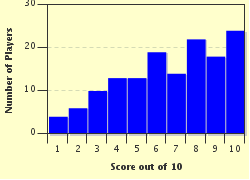Quiz Answer Key and Fun Facts
1. Easy start: What is the atomic number of oxygen?
2. In which century was oxygen discovered?
3. Besides the normal oxygen molecule consisting of two atoms, there is also the Trioxygen (O3) molecule, better known as ozone. What shape does that molecule have?
4. What percentage of a human body (by mass) is actually made of oxygen?
5. If you look at the Earth's crust, you will find that almost half of it is oxygen. In which form is most of this oxygen bound?
6. In chemical reactions, oxygen usually takes a -2 valence, accepting two additional electrons. The resulting compounds are usually called oxides, but there is one element with which oxygen actually reacts to a +2 state. Which one?
7. If pure oxygen is needed in large quantities (for industrial use), how is it usually generated?
8. A major class of chemical reaction is the redox reaction, consisting of a REDuction and an OXygenation. Which statement is true about redox reactions?
9. When looking at the electron shells of oxygen, we find the configuration 1s2 2s2p4. Two of these electrons are unpaired and determine the high reactivity of oxygen. Which two are they?
10. Here's a question for the etymologists among you: Why is "oxygen", translated from its Greek roots, somewhat of a misnomer?
Source: Author
WesleyCrusher
This quiz was reviewed by FunTrivia editor
rossian before going online.
Any errors found in FunTrivia content are routinely corrected through our feedback system.


